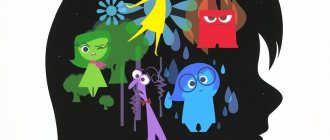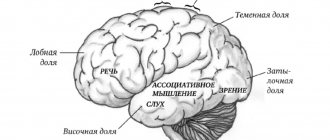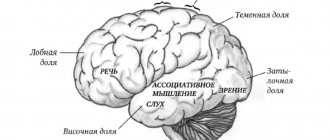What is perception
Within different sciences, the formulation of this term differs. So, for example, in philosophy, perception is understood as a mental action, as a result of which clear images of objects in the surrounding world are formed in the human mind. At the same time, perception, by definition, is the result of a person receiving information about the surrounding reality, that is, it is a complete image of an object or phenomenon.
Important! Synonyms for perception are concepts such as “sensory cognition” and “perception”.
Signs of perception
Perception is a cognitive process in psychology, the result of which is the formation of a subjective picture of the world through the direct impact of an object or phenomenon on the human senses.
Personality orientation - what is it in psychology, its types
The completed image of an object in the human mind is formed as a result of the combined work of various analyzers. Thus, through vision one can draw a conclusion about the color of an object, and through tactile palpation one can obtain information about its texture. If you take an object in your hands, you can feel its weight, with the help of smell you can feel its smell, and through the receptors on the tongue you can determine the taste. It turns out that in the process of getting to know a subject, cognition and perception merge together.
Important! Perception is always subjective. Individual characteristics of the work of analyzers and a person’s life experience explain the fact that the finished image of an object perceived by different people may differ. The process of perception is inextricably linked with thinking, attention, memory, speech, and the emotional-volitional sphere.
Levels of perception
Mechanical memory - what is it in psychology and how is it characterized?
The process of forming a holistic image of an object goes through 4 levels:
- One of the analyzers notices the object. A person can see it, smell it or hear some characteristic sound.
- Correlating the signal from the analyzer with a particular object. This process occurs with reference to the existing in memory ideas about the objects of the surrounding reality and the correlation of the detected feature of the object with one or another standard.
- Identification and identification. As a result of mental activity, a person comes to the conclusion about what kind of object it is, what it is called, and what it is needed for. The result of the process is the formation of a complete image of the object.
Forming an image of an object
Division by nature of activity
Considering the main classifications of perception, this division option cannot be left without due attention. It is assumed to distinguish between unintentional (involuntary) and intentional (voluntary) perception.
The first type is not associated with any goal; it acts as a component of another activity.
Voluntary perception is considered the highest mental function, which is inherent only to humans. It presupposes a clear statement of goals and objectives, is systematic and planned, and acts as a cognitive perceptual activity (observation).
Types of perception in people
All analyzers always participate in the process of accepting the surrounding reality, but only 1 of them is the leading channel for obtaining information. So, when reading, the leading channel is vision, when listening to music – hearing, etc. Perception is usually classified on various grounds.
By modality
Adolescence crisis in psychology - what is it, reasons
According to modality, the following types of perception are distinguished:
- Visual – the formation of a complete image of an object in the mind;
- Auditory – the ability to perceive sounds;
- Tactile - obtaining information about a particular thing through touching it;
- Olfactory – the ability to distinguish odors;
- Gustatory – expresses the formation of ideas about food based on the work of taste buds.
Depending on the host analyzer
Depending on which analyzer is the leading one, perception is divided into simple and complex. Simple types include kinetic (based on sensations and movement), auditory (based on hearing) and visual (based on vision).
The main complex types and properties of perception are based on a combination of signals from different senses. If a person equally often relies on 2 or more analytical systems, this leads to the development of motor-visual-auditory or motor-visual perception.
Additional Information. In addition, there are special types of perception that appear in a specific situation during certain human actions. For example, when a person determines the distance to a destination, one type of perception is at work. When a man thinks about how a girl treats him, analyzing her behavioral reactions, another type of this mental process is activated.
How does she feel about me?
By update method
In psychology, such types of perception are distinguished as voluntary and involuntary. If this process is voluntary, then it has a specific goal, and the person takes specific actions to achieve it. Voluntary perception occurs when a person reads a scientific text with the desire to learn something new.
Involuntary perception is due to the bright characteristics of the object. It manifests itself, for example, when a late student enters the classroom - everyone present turns their heads at the sound of the door opening.
Division by modality
By analyzers it is customary to distinguish:
- visual;
- tactile;
- auditory;
- taste;
- olfactory.
What is this version of perception? Classification involves division based on analyzers. The visual option involves examining the entire image of an object. It allows a person to immediately perceive complex forms of an object (geometric features and structures). Visual perception is involved in the perception of movement and space.
You may be interested in: Two-syllable words: definition, examples
Auditory perception is associated with the auditory analyzer. Within the framework of the social development of human society, two systems were formed: rhythmic-melodic (musical), phonemic (language system). They both organize the sounds that humans perceive into complex systems of auditory perception. The classification is conditional and depends on various factors. Auditory perception is an active process that includes some motor components. In it, the motor components are separated from the auditory system and allocated for singing with a voice or speaking out loud.
Tactile perception is associated with skin and motor sensations. Gradually, during tactile perception, the information that comes from individual features turns into a single image. To move from evaluating specific elements to analyzing the entire object, it is necessary that the hand be in motion (passive tactile perception must change to active feeling of the object).
You will be interested: Gurba are noisy people: interpretation of the word and synonyms
The olfactory variant is associated with the perception of odors based on the olfactory analyzer (nose). Psychologists have proven that with a strong influence on sensation, a person’s psychophysical state changes. In some cases, a perverted perception of odors occurs, namely, familiar substances become unpleasant.
Taste is perceived using the tongue (taste analyzer). In case of difficulty in nasal breathing, taste sensitivity also decreases. The reason is the loss of information, since the brain perceives food in the aggregate of all analyzers, and if one of them is lost, the picture is significantly distorted.
Basic properties of perception with examples
The mental process under consideration has the following properties:
- Integrity is a characteristic of the final image that arises as a result of a combination of sensations. The final image is always complete. For example, a fly is perceived by a frog as an object of hunting only when the fly moves. If the fly is motionless, the frog does not try to catch it, since it does not perceive it as an insect.
- Constancy - once acquired characteristics of a particular object, a person tends to correlate it with this particular object for a long time, accurately forming the final image. Minor changes in the characteristics of an item do not lead to difficulties with its classification. So, for example, a young man dates a tall girl who has blue eyes and blond hair. One day his girlfriend dyed her hair brunette. But he still perceives her as his partner; she has not become a stranger to him.
- Subjectness - the ability to combine an object with a generic group according to key characteristics. For example, green, round, sweet - this is an apple. Green, long, with paws and a tail - this is a crocodile. The process of classifying items into generic groups may take some time. Sometimes, for a correct correlation, a person needs to come up and take a closer look at the object or pick it up.
Objectivity of perception
- Structurality is reflected in the complexity of the perception process, which cannot be reduced simply to the sum of sensations from different senses. Replacing one of the key characteristics leads to the formation of a completely new image. So, for example, something large, iron and capable of floating is a ship. However, a large, iron one, capable of moving along railroad tracks is a train, not a ship.
- Selectivity – selection of 1 object from the background. The scope of perception is limited. A child cannot play with many toys at the same time. First of all, he will take the brightest or largest toy. This turns on selectivity: the baby chooses the most eye-catching object by color or size. Having chosen his favorite toy from a variety, the child loses interest in the others for a while; only the best one is in his field of perception.
- Apperception is the dependence of image formation on the individual characteristics of a person’s analytical systems and his life experience. The same object can be perceived differently by different people. So, for example, the Bible for believers is one of the main books of life, which sets out the rules of life and the foundations of society, but for an atheist it seems to be just a book that is no different from any other work of art.
- Perception activity is a person’s ability to be aware of the surrounding reality and accumulate experience in using objects. For example, initially the baby does not know what function the spoon performs. He can knock on the wall with it, look at it like in a mirror, dig sand with it. One day his mother shows him that he can eat with a spoon. Having learned this, the baby understands that a spoon is a cutlery, and not a hammer, a mirror or a spatula.
Errors in Perception
As in any other mental process, errors occur in perception, as a result of which a person forms erroneous ideas about objects and phenomena. Typical perceptual errors include illusions and hallucinations.
Illusion
Illusion is a distorted perception of objects or phenomena. There are 2 types of illusions:
- Affectogenic illusions caused by emotions and feelings. For example, a timid person can clearly see a monster in the shadow of a bush, while a person with low self-esteem seems to be disliked by his superiors and is constantly being picked on.
- Pareidolic illusions, which are characterized by the appearance of fantastic images when interacting with reality. For example, black spots on a white sheet can be mistaken by a person for insects.
Hallucinations are a type of image that does not actually exist. Hallucinations are one of the symptoms of a mental disorder. So, a person can hear voices, he can imagine the presence of someone in the room, although at that moment in time there is no one next to him, and he is in silence.
Additional Information. A healthy person may experience hallucinations as a result of using psychotropic substances. Hallucinations can also be induced through hypnosis.
Third way
Classification according to the method of perception: duration, nature involves the identification of two types:
- simultaneous;
- successive.
The first version of perception is a one-time action, unfolded in space. It is distinguished by integrity and generality. For example, at the first lecture, the teacher perceives the audience as a whole; it is difficult for him to single out each student.
Successive perception presupposes phasing; it is unfolded in time. For example, it appears when checking errors in dictation.
Person's perception by person
In social science, a peculiarity of people's perception of each other has been identified. When meeting someone, it is not possible to obtain enough information to form a complete, complete image. Only in the process of long-term communication do people get to know each other so much that a psychological portrait of a friend is formed in their minds.
At the time of the first meeting, people try to make a good impression if they are interested in a communication partner. They seem to stand on their tiptoes, wanting to become morally superior. At the very beginning of a relationship, people diligently disguise their shortcomings and weaknesses. A person’s primary image of an interlocutor is formed based on an analysis of his posture, posture, gestures, and communication style.
People's perceptions of each other
In addition, if the interlocutor reveals his profession, the person mentally attributes to him the stereotypical qualities of a typical representative of a particular field of professional activity. Thus, people tend to believe that teachers lead a correct lifestyle, and musicians are vulnerable, impressionable, and romantic.
A person’s social status also has a significant impact on the opinion others have about him.
Interesting fact. If a person has a beautiful appearance, then communication partners tend to endow him with positive personal qualities that he actually does not possess. If outwardly the interlocutor reminds a person of one of his relatives, sympathy for him arises from the first minutes of communication.
Development of perception in children
The foundations of perception as a mental process are laid in infancy. However, at an early age, the baby’s perception is still very imperfect. In the first years of life, a child develops visual-tactile and visual-motor connections that arise in the process of manipulative activities with objects. Later, the manipulation turns to “feeling” a new object with the gaze - this indicates a new stage in the development of perception.
In preschool and primary school age, perception is determined by the impressionability and emotionality of children: involuntary perception prevails over voluntary perception.
The most difficult for children to master are the spatial properties of objects that are associated with visual, kinesthetic and tactile sensations. During preschool childhood, children successfully master concepts such as shape, size and size of objects, learn to determine the distance and spatial arrangement of objects relative to each other.
The perception of time poses serious difficulties for children of primary preschool age. They do not always correctly use the words “tomorrow”, “yesterday”, “later”, “earlier”.
Children's perception of time
As the child masters the surrounding world, as well as systematic schooling, the child’s conditioned reflex connections improve, which is an impetus for the development of perception.
The key role in the development of children's perception belongs to adults. Thus, parents and teachers teach children how to operate with objects, guide the child’s development process, and draw his attention to the essential characteristics of objects and phenomena of reality. An adult’s detailed and complete answers to a child’s questions about certain objects and phenomena will mean a lot.
Attention! To develop a child’s perception, it is necessary to organize his play and practical activities with objects. During the game, children learn to distinguish the basic properties of objects: color, weight, shape, size. In order for a child to study an object and understand its purpose, he needs to touch it and try to perform various actions with it. During the game and practical activities, optimal conditions are created for the interaction of analyzers, which leads to the formation of a holistic view of the world.
Children's artistic activities have enormous potential for the development of perceptual skills. In drawing from a model and in the process of sculpting, children learn to feel proportions, convey the shape and size of an object, and distinguish between shades of a palette. Thus, by older preschool age, the child’s perception becomes controlled and arbitrary.
During the period of schooling, perception is improved due to the variety of academic disciplines and various types of activities of children under the guidance of a teacher. To develop perceptual skills, the teacher must use visual aids: firstly, this stimulates the work of several analyzers at once, and secondly, it contributes to better memorization of information. Independent search work of students is of great importance.
Thus, perception plays an important role in human life. Perceptual skills formed at a high level ensure successful learning, harmonious personal development, and the ability for scientific creativity. It is important for adults to remember that this ability will not be formed by itself; it is necessary to create conditions for the child to play with different objects from an early age. It is important in early childhood to give the opportunity to develop sensory standards and cognitive interest. If these conditions are met, during school the child will be active and independent in learning about the world around him.
Brief perception of reality
Let's sum it up
Among the main properties of perception that are of interest, psychologists highlight structure, integrity, activity, meaningfulness, consistency, and objectivity. They are what characterize perception. Classification and properties make it possible to create a certain idea of a person and establish connections between tactile and visual actions. To analyze the condition of a particular patient, it is important for a psychologist to first identify all types of perceptions, draw up a complete picture based on individual information, and only then give any advice.
Source







